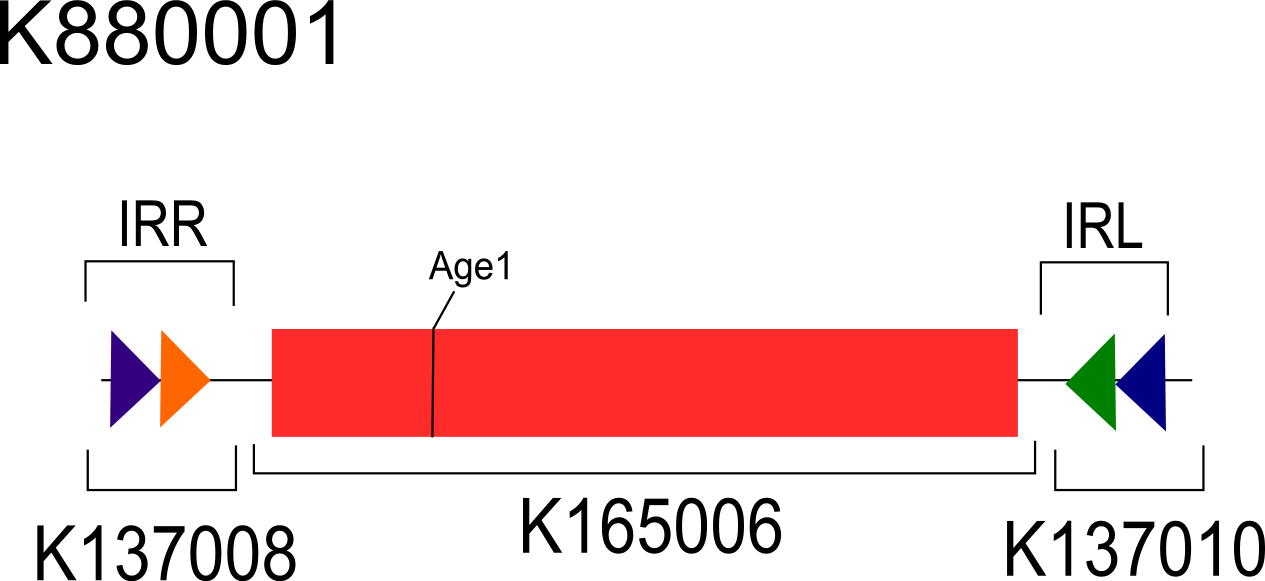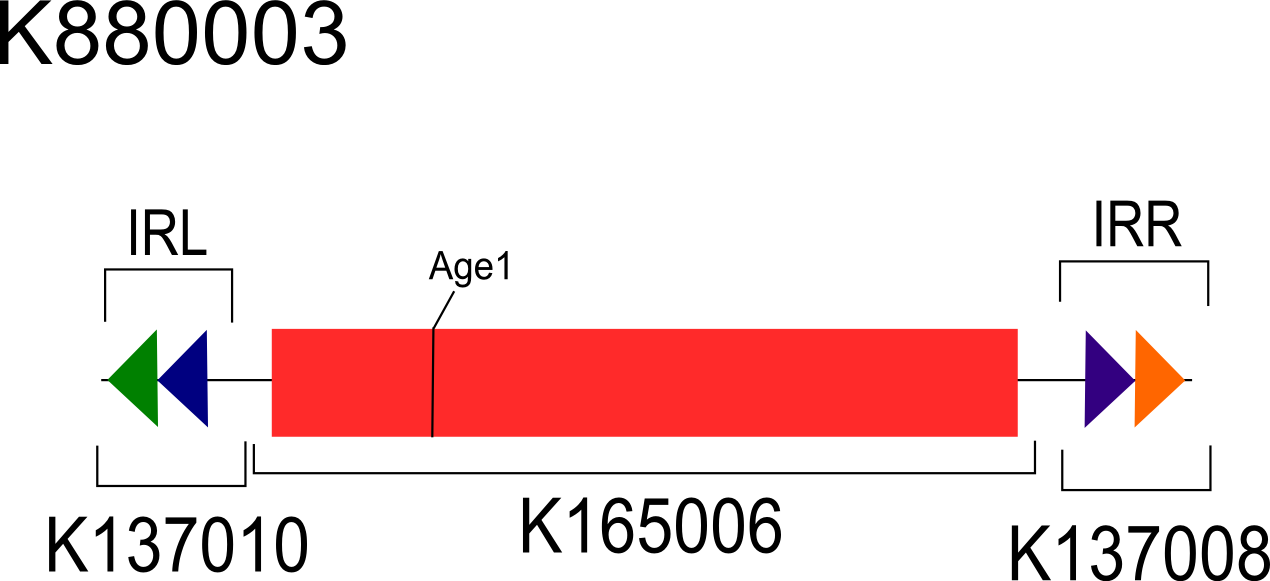Team:Michigan/Results
From 2012.igem.org
(Difference between revisions)
| Line 62: | Line 62: | ||
Modified Asymmetrically Digestible Reporter (BBa_K880001) Data: | Modified Asymmetrically Digestible Reporter (BBa_K880001) Data: | ||
</h2> | </h2> | ||
| + | |||
| + | To test the hypothesis that the IRL and IRR orientations were the determinative factor to the inversion negative results observed, we created a second asymmetrical reporter (K880001). K880001 was engineered such that the IRL is situated on the right of the inverted region and the IRR is situated on the left. This IRL/IRR orientation restores the orientation as found in the natural <i>fimS</i> region (Gally et al., 1996) and a previously engineered recombinase systems (Ham et al., 2006 ). | ||
| + | <br> | ||
| + | The new asymmetrical digest reporter (K880001) in the vector pSB3C5 was co-transformed in 10-beta <i>E. coli</i> (NEB) with strong, constitutively expressed FimE (K880005-K137007) in the vector pSB1A2. Co-transformants colonies were analyzed for inversion using the asymmetrical digest assay (hyperlink to protocol) . The asymmetrical digest reporter and <i>fimE</i> (700bp band Fig7, Lanes 2-4) are both present within the co-transformants. The asymmetrical digest reporter was observed in a partially flipped state exhibiting both the 353bp band as well as the 255/238bp bands (Fig 7, Lane 2-4). It has been noted that fim inversions induced by FimE in a previously engineered recombinase systems exhibited low efficiency resulting in a mixed population of flipped and unflipped inversion regions (Ham et al., 2008). | ||
| + | <br> | ||
| + | <br> | ||
| + | To further characterize the new asymmetrical digest reporter (K880001) in the vector pSB3C5 was transformed into <i>E. coli</i> DH5</i>, a strain with endogenous FimE. In accordance with the co-transformation experiment, the asymmetrical digest reporter was observed in a partially flipped state (Fig 8, Lane 2). | ||
| + | |||
| + | <br><br> | ||
<h2> | <h2> | ||
Revision as of 00:20, 4 October 2012
Introduction
In order to test the effectiveness of the recombinases used in our system, we developed two assays -- an “asymmetrical digest” reporter and a fluorescence reporter. The former is used to directly test the inversion of the target DNA region, while the latter is used to demonstrate inversion induced protein expression.The Asymmetrical Digest Reporters
The two asymmetrical digest reporters in their unflipped state (invertible by FimE) are shown in figures 2 and 3. These reporters rely on an off-center AgeI restriction site which will yield fragments of varying size depending on the orientation of the inversion region. Table 1 shows the expected sizes of the fragments in each orientation. The differences between the reporters are discussed below.The Fluorescent Reporters
The fluorescent reporters, show in in figures 3 and 4, have a constitutive tetR promoter within the inversion site, allowing for the expression of GFP in the flipped orientation.
Results
Negative Fluorescent Reporter (BBa_K137058) Data
To initially test the FimE recombinase, we utilized a reporter created by the CalTech ‘08 iGEM team (BBa_K137058) for the same purpose. The K137058 reporter in the vector pSB3C5 was co-transformed in 10-beta E. coli (NEB) with strong, constitutively expressed FimE (K880005-K137007) in the vector pSB1A2. Despite several co-transformation trials, no fluorescence was observed in contrast to CalTech ‘08’s results.Negative Asymmetrically Digestible Reporter (BBa_K880003) Data
An asymmetrical digest reporter (K880003) in the vector pSB3C5 based on the inversion region found in K137058 was co-transformed in 10-beta E. coli (NEB) with strong, constitutively expressed FimE (K880005-K137007) in the vector pSB1A2. Colonies as well as broth subcultures of co-transformants were analyzed for inversion using the asymmetrical digest assay (hyperlink to protocol) . The asymmetrical digest reporter and fimE are present within the co-transformants; however, the asymmetrical digest reporter remains in the uninverted state (Fig 5, lane 3).Observation of IRR and IRL Orientation:
Scrutiny of the DNA sequence provided a possible explanation of the negative results. As constructed, verified by sequencing, the orientations of IRL(K137010) and IRR (K137008) within the inversion region of K137058 were orientated 180º when compared to the natural fimS region (Gally et al., 1996) and a previously engineered recombinase systems (Ham et al., 2006). This resulted in the IRL and IRR being oriented such that the external half-sites are localized adjacent to the inversion region, while the internal half-sites are located externally (Fig 6). We hypothesize that this 180º orientation of the IRL and IRR is the determinative factor to the inversion negative results.Modified Asymmetrically Digestible Reporter (BBa_K880001) Data:
To test the hypothesis that the IRL and IRR orientations were the determinative factor to the inversion negative results observed, we created a second asymmetrical reporter (K880001). K880001 was engineered such that the IRL is situated on the right of the inverted region and the IRR is situated on the left. This IRL/IRR orientation restores the orientation as found in the natural fimS region (Gally et al., 1996) and a previously engineered recombinase systems (Ham et al., 2006 ).The new asymmetrical digest reporter (K880001) in the vector pSB3C5 was co-transformed in 10-beta E. coli (NEB) with strong, constitutively expressed FimE (K880005-K137007) in the vector pSB1A2. Co-transformants colonies were analyzed for inversion using the asymmetrical digest assay (hyperlink to protocol) . The asymmetrical digest reporter and fimE (700bp band Fig7, Lanes 2-4) are both present within the co-transformants. The asymmetrical digest reporter was observed in a partially flipped state exhibiting both the 353bp band as well as the 255/238bp bands (Fig 7, Lane 2-4). It has been noted that fim inversions induced by FimE in a previously engineered recombinase systems exhibited low efficiency resulting in a mixed population of flipped and unflipped inversion regions (Ham et al., 2008).
To further characterize the new asymmetrical digest reporter (K880001) in the vector pSB3C5 was transformed into E. coli DH5, a strain with endogenous FimE. In accordance with the co-transformation experiment, the asymmetrical digest reporter was observed in a partially flipped state (Fig 8, Lane 2).
 "
"



